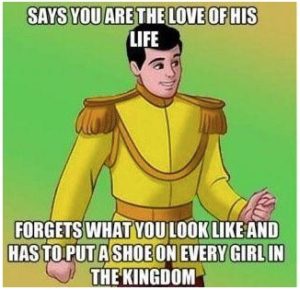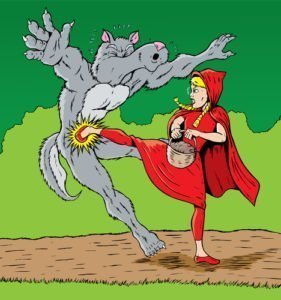Weeks 2 & 3 (Make Cycle 1: Fairy Tales)
 Make Cycle 1: Fairy Tales
Make Cycle 1: Fairy Tales
Aug 28-Sept 12: Weeks 2 & 3
This week kicks off our “make cycles” with a look at fairy tales and their role in our culture. (This will also give us a chance for your book choices to arrive.) Fairy tales are also (obviously) a big part of children’s lives and can be used in such interesting and playful ways in your future classrooms. They can also be problematic when we consider how limited some fairy tales are when offering up ideas about who we get to be and how we must behave. The Common Core Standards for English Language Arts (ELA) in second grade asks students to: “Recount stories, including fables and folktales from diverse cultures, and determine their central message, lesson, or moral.” CCSS.ELA-LITERACY.RL.2.2 We’ll think about how we might use fairy tales productively in our teaching.
By the end of our two week “Fairy Tale Cycle” we will be invited to:
- Read various versions of well known fairy tales: Little Red Riding Hood and Cinderella.
- Write responses to these readings and respond to other’s. (All posts in our Currents Community)
- Create your “Make”: Make your own version of one of these tales in the form of a poem or new, short version, new ending, or piece of art.
And just in general, make sure you’re checking email and that our Announcements are not going to your junk folder. 😉 Thank you!
Here’s a video for some context for our tasks below here too:
Week 2: Aug 28-Sept 5
By Wednesday, Sept 1: Post a response:
Prompt: What makes a story a fairy tale? What are the elements? Why do we continue to read fairy tales? What role do fairy tales serve in our culture? What are your memories of fairy tales? NOTE: this prompt is just asking for your initial thoughts: you can refer to the readings below or anything you’ve read about fairy tales or not. You could just cull from your experiences with fairy tales throughout growing up. The purpose is to start an exploration into what you think about fairy tales and what you think they do for cultures. Post in Currents under heading Week 2: Fairy Tale (Little Red).
After you post, comment on a peer’s post: tell them what you like, what is interesting, where you agree, etc. This will ALWAYS be our routine: post one and then respond to one. We’re building a community of readers and teachers. 😉
*NOTE: I would look at the examples from previous students to get a sense of the depth I’m looking for in these responses: Example Student Work page
By Sunday, Sept 5: Read and then respond to the prompts below:
Read Maria Tatar’s “Little Red Riding Hood” intro (just pages 3-10) and versions of LRRH linked below.
*Note, after reading the introduction information about Little Red Riding Hood (LRRH) in this linked PDF, I figured you might find it easier to read the actual versions of the tales in another format; quite frankly, the pdf is not super easy to read on the screen and I didn’t want you to buy another book. I’ve linked to a resource at Pitt University, which has many versions of the tales and is a great resource for teachers. And before you have anxiety over the number of versions you need to read, you’ll notice once you click that some are only half a page of writing. Read the intro in the pdf and then: 1) either keep reading the pdf (read Dahl’s version and choose 4 more versions to compare); OR, 2) read the intro in the pdf and then use the links below to read the versions of the LRRH tales since the sites are more readable.
- So, start by reading the introduction to LRRH cycle here “Little Read Riding Hood” (just pages 3-10); this will give you a whole bunch to think about in terms of versions of the Little Red Riding Hood tales
- Then:
- Choose 4 versions on this page to read and compare: Link to the Pitt resource with versions of the Litte Red Riding Hood tales.
- Read Roald Dahl’s Little Red Riding Hood and the Wolf
Once you’ve read, then write a response to the following prompt:
Prompt 1: In the introduction to The Classic Fairy Tales, Maria Tatar lays out the debate around the cultural role of fairy tales. She explains, “Some advocate for the recuperation and critique of the classic cannon; others have called for the revival of ‘heretical’ texts (stories repressed and suppressed from cultural memory) and the formation of a new canon; still others champion rewriting the old tales or inventing new ones” (xiii). She goes on to quote Dworkin who sees fairy tales as imprinting cultural absolutes; Dworkin argues that we take the roles offered in fairy tales as “real identity.”
Unpack this debate given your reading of the Little Red Riding Hood (LRRH) Cycle of stories; what do we learn by these various “tellings” of this story? What are the implications of these tales in terms of identity construction? What roles are offered in the tales for children to imagine? How is this helpful/problematic? Are some versions of LRRH offering more helpful role models for children to imagine, for example? Do you think we should abandon these tales and write new ones or is there value in reading these LRRH stories as they were written? Point to specific tales in Little Red Riding Hood as examples to think through these ideas.
Post in Currents under heading Week 2: Fairy Tale (Little Red). After you post, comment on a peer’s post: tell them what you like, what is interesting, where you agree, etc. Again, Example Student Work page here
Week 3: Sept 6-12
By Wednesday, Sept 8: Read
- “Cinderella History” from the Sur La Lune site;
- choose 4 versions of Cinderella to read from the Pitt site, and;
- read “The Tale of the Shoe” by Emma Donoghue

Then, write a response to the following TWO prompts:
Prompt 1: Compare the versions you read from the Pitt site: what kinds of roles and identities are offered in these tales? How do the versions compare to versions of Cinderella you grew up with? Problems with these tales? Or things you like about these tales that you could use with children in your future classroom?
Prompt 2: In what ways does Emma Donoghue undermine the conventions of the fairy tale? How is her version of Cinderella different? Do you have favorite passages or lines from this version (share with us)?
Post in Currents under heading Week 3: Fairy Tale (Cinderella). After you post, comment on a peer’s post: tell them what you like, what is interesting, where you agree, etc.
By Sunday, Sept 12: Our “Make” for this week.
The Make assignments that we’ll do throughout the semester have two parts:
- The make itself
AND
- a brief artist’s/writer’s statement explaining what you were attempting to do with this make: how did you approach the creation of this artifact? what worked? what did not work out as planned?
A few choices here for our makes this week: a remix of the tale by writing a poem, or writing a fractured fairy tale from another character’s point of view, or write a new ending to a classic fairy tale, or create a piece of art that remixes the tale. See ideas below:
One choice: Compose your own revision of a favorite tale by writing a poem or new short version of the story using its elements. You could imagine your version taking on the perspective of the prince, the step-sisters, step mother, mice, fairy godmother, etc if you were working with Cinderella, for example… Or change the setting of the story… Or tell us what happens later in the story. Lots of examples in pop culture using old tales to tell new stories (Shrek, The True Story of the Three Little Pigs, Ever After…there are thousands, right?) Here are some examples:
The Paperbag Princess is a great rewrite of the traditional princess role; you can listen to the book in the link above.
Prince & Knight is one of my new(er) favorites.
In Search of Cinderella
From dusk to dawn,
From town to town,
Without a single clue,
I seek the tender, slender foot
To fit this crystal shoe.
From dusk to dawn,
I try it on
Each damsel that I meet.
And I still love her so, but oh,
I’ve started hating feet. —Shel Silverstein
..And Then the Prince Knelt Down and Tried to Put the Glass Slipper on Cinderella’s Foot
I really didn’t notice that he had a funny nose.
And he certainly looked better all dressed up in fancy clothes.
He’s not nearly as attractive as he seemed the other night.
So I think I’ll just pretend that this glass slipper feels too tight. –Judith Viorst
OR another choice: create a piece of art (drawing, etc) that revises one of these fairy tales. When you share it in Currents (you can upload a picture(s) or link), explain to us what you’re hoping to illustrate through your art.
OR another choice: write a few paragraphs exploring further how you might use fairy tales in your teaching. Feel free to curate resources you find online for teaching fairy tales and link to them. You could offer a critique of the teaching resources: are the resources useful, problematic, a little of both?
Post in Make 1: Fairy Tale Makes. Remember to explain your creation no matter which option you choose: how did you approach this artifact? what worked? what did not work out as planned?
If you have another idea for a Make, then just let me know!
Some additional resources for support of your Makes:
The SurLaLune site: where you’ll find all things fairy tales: history, versions, illustrations…
Storyjumper: a great site that allows you (and your future students) to create their own stories and digital books. You could use this resource to write your own version or new ending of a tale. When you’re finished, just click on the “share” button to get the link to post on our Currents page.
Fairy Tale Lesson plan ideas to inspire